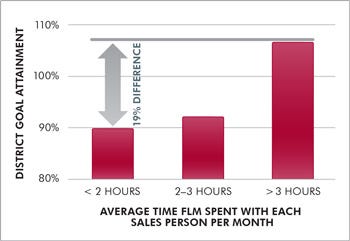In the New Medical Device Sales Model, Managers, not Reps, Need Better Training
Here’s a challenge: How do you cut costs – including cost of sales – while securing an effective promotional presence in the medical device market? The medtech space is seeing increased product commoditization and intense competition growth.How about another challenge: You just embraced value-based selling and account management processes to become truly customer focused. But your customers aren’t buying it. Nor are your salespeople. Do you throw in the towel?
The European head of a U.S.-based manufacturer of orthopedic products faced these same issues. To do more with less, he decided to consolidate sales and service roles, and stretch salespeople’s skills and capabilities. The team had to handle a larger portfolio of products and services. The sales team had to be credible with the clinical and economic elements of our value proposition, even as they faced increasingly powerful and sophisticated buyers. The salespeople also needed to make a smooth transition to broader roles without hurting the business.
The critical link to solve these multiple problems was to put in a very strong first line manager team.
As the medtech industry faces the very real market challenges of addressing costs and a shifting buyer, an increased focus on sales managers is critical. Placing sales managers at the center of sales effectivenesss can improve sales performance.
.jpg?width=700&auto=webp&quality=80&disable=upscale) New Market Challenges and Manager Roles
New Market Challenges and Manager Roles
.jpg?width=700&auto=webp&quality=80&disable=upscale)
Significant change is occurring in the medical products space. Manufacturers see their customers’ buying decisions move from clinical to economic decision criteria, and decision processes move from local facilities to integrated delivery network (IDN) headquarters, group purchasing organizations (GPOs), and government entities. This shift of leverage to the economic buyer is accelerating and now affects virtually all product categories. To survive these challenges, manufacturers must make significant changes to their value propositions, go-to-market strategies, and sales processes.
Success, however, relies on the sales organization’s capability to execute changes effectively. And having a strong first-line management (FLM) team is vital to achieving this goal. FLMs help transform selling organizations and guide and motivate sales and service people in their evolving roles. They help salespeople make critical moves to engage their customers and build deep relationships. They counsel, coach, or replace salespeople until the entire team is excellent.
The quality of an FLM significantly impacts the quality and results of the sales force. Research has shown that reps hired and managed by top FLM show a significantly better performance trajectory than those hired and managed by an average FLM (see Figure 1).
In 2004, a study by Wilson Learning Worldwide showed a 29% increase in top-line performance due to the skills of sales managers, independent of the skills of their salespeople. Along the same lines, the Sales Executive Council reported a four-fold difference in top-line territory growth of reps under “star managers” (top 10%) compared to reps under weak managers (bottom 10%). The same report showed sales results of teams managed by the top 25% of managers were 30% higher than teams under average managers—and the sales difference between the top 25% and bottom 25% of managers was a stunning 80%. Job satisfaction for reps in a team of “star” managers was 50% higher than those with poor managers, while 70% of reps left the company because of perceived poor performance of their manager.
In summary, a strong FLM team drives superior execution and competitive advantage, but a weak team may derail the sales organization or damage customer relationships and morale.
Watch out for Pitfalls
Not all companies find it easy to develop and maintain a strong FLM team. The challenge starts with bringing new FLMs into the team to fill a new or vacated position. You will likely look first within the firm, perhaps within the sales representatives’ pool, to find a new FLM. It makes sense, since these employees understand the products, customers, and culture. However, too often, reps promoted from within experience difficulties in making the leap from an “individual contributor” to “winning through others.” It is not a trivial shift in mindset. Making the adjustment can take several years, which hinders the FLM.
In particular, there are two elements of the FLM role where medical device companies commonly struggle. These elements become increasingly visible as companies look to raise effectiveness in a selling environment of progressive complexity:
The FLM role is often the first career step to require coaching and a formal supervision of others. Although med device reps may have informal authority to direct others in the field (for instance, clinical specialists, applications specialists, and product specialists), the real authority nearly always resides with the FLM, rather than a salesperson. The pressure for short-term results and the fact that FLMs were typically top sales representatives, often leads to an overemphasis on super rep activities, such as closing big deals and maintaining customer relationships, rather than coaching on deal preparation, call planning, and observational coaching or feedback.
The FLM role is often the first one to significantly control price. Many medical device sales representatives have limited pricing authority. FLMs require strong business acumen, but such knowledge is often not present nor do FLMs receive proper training. FLMs struggle though negotiating pricing exceptions, not because of a lack of negotiations skills, but rather due to their limited capability to anticipate the impact of individual pricing decisions on the overall business.
Examples of Successful FLM Assessments and Transformations
Case 1: Global Orthopedics Manufacturer
At first, the manufacturer of orthopedic products believed —perhaps spurred by the industry-wide buzz around value-based selling and account management —that the biggest opportunity was to establish a key account management (KAM) team.
However, after conducting market research into customer needs and expectations, the company determined most customers were not yet ready to purchase in a way that called for a KAM organization. Instead, the KAM option was deployed to the very few who were open to it and cross selling across the business. T the company still had to figure out how to meet the needs of the majority of customers who preferred a more transaction-oriented approach.
A closer look revealed opportunities to enhance customer engagement with these accounts were far from exhausted, even without moving to KAM. Although there were some pockets of excellence, knowledge and approaches varied widely across the organization, and success seemed more a result of luck than method. The FLM team was not equipped to drive their teams to excellence on a broad scale.
The company decided to embark on a multistage journey to improve the FLM team through training. Specifically, improvements focused on the following:
1. Clarifying the role and expectations across the organization, resolving any discrepancies among the leadership, and developing a robust competency model.
2. Assessing the entire FLM via the agreed-upon competency model and determining who among the team required follow-ups (e.g., more drastic training, replacing, or removing).
3. Creating a forum for best practices to be shared, via peer-to-peer methods, including face-to-face discussions similar to town hall meetings, and electronic methods similar to social media.
4. Improving the hiring methods via an overhauled recruiting and hiring process, as well as updated assessment materials such as simulations and cases.
This multipronged approach combined the best of what they had with the best of what they could develop. The FLM work required approximately three months with a small core team. Outcomes include improved processes, skills and tools, as well as a clear strategy toward customer segments and required approaches.
Case 2: Global Blood Glucose Monitoring Manufacturer
This organization suffered from a lack of communication between the field and headquarters, which led to a lack of trust across the business. Not surprisingly, nobody had a clear view about what anybody was doing, let alone what approaches worked.
Similar to the first case, the FLM role was perceived as the critical link between central strategy and field execution, but there was also wide variation in the activities of various FLMs.
With information transparency as one of the key drivers, the company organized a core team to drive understanding and improving FLMs.
Diagnosis
First, a third-party partner conducted a confidential time-allocation survey among all the company’s FLMs. The survey results were then combined with performance history, analyzing links between behaviors and performance among cohorts of managers.
In parallel, a survey was conducted among FLMs that gathered their attitudes about elements of their role. This revealed significant differences in expectations. Some thought their role should be a “super-rep” to focus mostly on driving big deals. Others thought their role was mostly about coaching, and others expressed their role as driving sales while reps supported them clinically.
Improvements
They next focused on improvements. The first improvement was to develop a clear competency model for the role ((what is that? How do you develop one?)). They also developed guidelines on target time allocation across a variety of activities, such as time in the field and time spent on administrative tasks. These guidelines were derived from the analysis of “best practices” among segments of FLMs from the time-allocation study.
Support
Finally, the organization developed practical materials to support the improved processes, such as feedback guides (upward and downward), observation guides, coaching role-plays, and territory analysis cases. This reinforced the competency framework and practiced appropriate behaviors in a structured way.
As with the first case, this company found it needed to change expectations and behaviors as part of a multipart strategy. It took the organization about six months to develop and rollout the various elements and see real changes in behaviors. Qualitative outcomes have been positive. A follow-up time allocation survey to track progress will take place one year post-launch.
 Where to Begin
Where to Begin

FLM excellence is an underleveraged opportunity for many medical product manufacturers. Most companies focus on redesigning customer-facing roles and building a team of excellent sales and service people. They devote too little attention to designing and building the FLM team, which is truly "the force behind the sales force." Instead, we’ve observed a potential recipe for disaster: an increasing managerial span-of-control, an increasing number of roles reporting to one manager, and a lack of FLM training.
Investments that make the FLM team stronger pay off. Building a winning FLM team helps medical products manufacturers capitalize on a high-impact, tangible opportunity to drive sales effectiveness and top- and bottom-line results. Research consistently shows time in the field is correlated with sales results (see Figure 2).
Where can you begin? As seen in the above cases, the methods for investigating issues and finding workable solutions vary from company to company. However, in our experience, some key ideas emerge frequently:
Create role clarity. Most companies already offer job descriptions for sales and service people, and many now have a defined sales process specifying how salespeople should work with customers. Make sure that you also define the varied responsibilities of managers with the same diligence.
Select well. Companies devote considerable energy to recruit the best sales talent, but usually just select their best salespeople for the FLM job. Avoid this trap. The success profiles for salespeople and FLMs can be considerably different. Past success as a sales representative is not a good predictor for success as sales manager.
Provide sufficient support. Medical manufacturers spend millions on training their sales forces every year, but very little is directed toward developing the skills of their FLMs, or toward offering support resources. That’s a mistake that creates inconsistent competency across the team. Training provides much-needed direction for new sales managers. In addition, provide best-practice sharing opportunities and develop simple tools, such as interview and observation guides, to support common activities.
Medical products companies are facing significant challenges. A key success factor to world-class execution is an excellent FLM team. Every medical device company should consider taking the steps outlined above to design, build, and nurture a top-notch FLM team to drive commercial success.
 Torsten Bernewitz is a Principal in ZS Associates’ Philadelphia office, and the global leader of ZS’ sales force effectiveness practice. He has over 25 years of experience as a management consultant as well as practitioner in sales, go-to-market strategy, and operations.
Torsten Bernewitz is a Principal in ZS Associates’ Philadelphia office, and the global leader of ZS’ sales force effectiveness practice. He has over 25 years of experience as a management consultant as well as practitioner in sales, go-to-market strategy, and operations.
 Tobi Laczkowski is an Associate Principal in ZS Associates’ Zürich office. He has over 10 years experience consulting with medical products clients in the Americas, Europe, and Asia. Tobi has particular expertise in sales force effectiveness, go-to-market strategy & transformation, organizational design, compensation design, value proposition design and recruiting effectiveness.
Tobi Laczkowski is an Associate Principal in ZS Associates’ Zürich office. He has over 10 years experience consulting with medical products clients in the Americas, Europe, and Asia. Tobi has particular expertise in sales force effectiveness, go-to-market strategy & transformation, organizational design, compensation design, value proposition design and recruiting effectiveness.
Related Content
The New Commerce: How Sales Models are Changing in Medical Devices
European Medical Device Companies Embrace New Sales Strategies
About the Author(s)
You May Also Like


